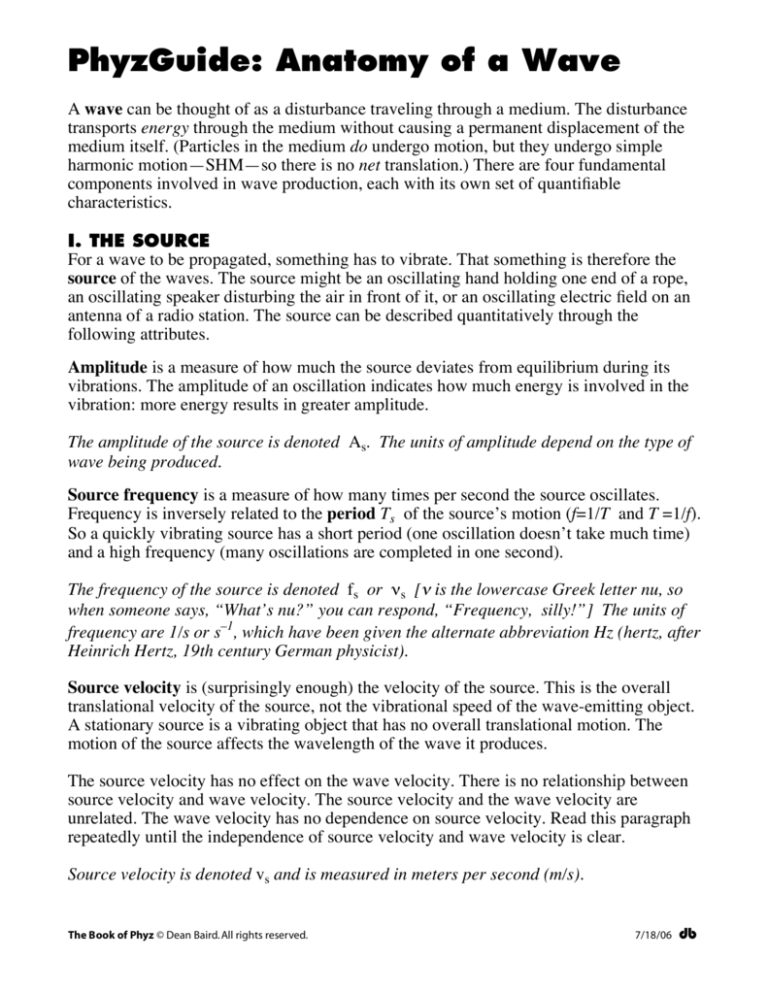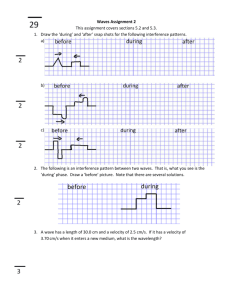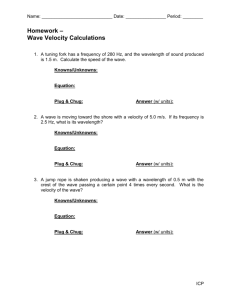
PhyzGuide: Anatomy of a Wave
A wave can be thought of as a disturbance traveling through a medium. The disturbance
transports energy through the medium without causing a permanent displacement of the
medium itself. (Particles in the medium do undergo motion, but they undergo simple
harmonic motion—SHM—so there is no net translation.) There are four fundamental
components involved in wave production, each with its own set of quantifiable
characteristics.
I. THE SOURCE
For a wave to be propagated, something has to vibrate. That something is therefore the
source of the waves. The source might be an oscillating hand holding one end of a rope,
an oscillating speaker disturbing the air in front of it, or an oscillating electric field on an
antenna of a radio station. The source can be described quantitatively through the
following attributes.
Amplitude is a measure of how much the source deviates from equilibrium during its
vibrations. The amplitude of an oscillation indicates how much energy is involved in the
vibration: more energy results in greater amplitude.
The amplitude of the source is denoted As. The units of amplitude depend on the type of
wave being produced.
Source frequency is a measure of how many times per second the source oscillates.
Frequency is inversely related to the period Ts of the source’s motion (f=1/T and T =1/f).
So a quickly vibrating source has a short period (one oscillation doesn’t take much time)
and a high frequency (many oscillations are completed in one second).
The frequency of the source is denoted fs or νs [ν is the lowercase Greek letter nu, so
when someone says, “What’s nu?” you can respond, “Frequency, silly!”] The units of
frequency are 1/s or s–1, which have been given the alternate abbreviation Hz (hertz, after
Heinrich Hertz, 19th century German physicist).
Source velocity is (surprisingly enough) the velocity of the source. This is the overall
translational velocity of the source, not the vibrational speed of the wave-emitting object.
A stationary source is a vibrating object that has no overall translational motion. The
motion of the source affects the wavelength of the wave it produces.
The source velocity has no effect on the wave velocity. There is no relationship between
source velocity and wave velocity. The source velocity and the wave velocity are
unrelated. The wave velocity has no dependence on source velocity. Read this paragraph
repeatedly until the independence of source velocity and wave velocity is clear.
Source velocity is denoted vs and is measured in meters per second (m/s).
The Book of Phyz © Dean Baird. All rights reserved.
7/18/06
db
II. THE MEDIUM
The medium is what the source disturbs. The disturbance propagates through the medium
at a specific speed. This speed is called the wave speed.
Wave speed is a characteristic of the medium only. Low amplitude waves travel at the
same speed as high amplitude waves in a given medium. Waves created by a low
frequency oscillator propagate at the same speed as those emanating from a high
frequency oscillator. Waves travel faster in stiffer materials (in which the molecules are
bound more tightly throughout—when one molecule is disturbed from equilibrium, it
quickly disturbs its neighbor, and so on... hey, this sounds like my apartment complex).
Wave speed is denoted vw and is measured in meters per second (m/s).
III. THE WAVE
The disturbance itself has certain quantifiable features, too.
Amplitude is a measure of how much the wave disturbs the medium, and is an indication
of the energy being transported by the wave.
Amplitude is denoted by an A.
Wavelength is the distance between consecutive wave crests. Wavelength depends on
two quantities: the frequency of the source fs, and the wave speed in the medium vw. If the
source vibrates quickly (high frequency), then many waves will be loaded into the
medium each second, and the waves will therefore be closely packed (small wavelength).
So λ ∝ 1/fs. If waves travel quickly through the medium, one wave will be carried a great
distance before the next one is loaded. So λ ∝ vw. Taken together, we can conclude that
the wavelength of a wave is proportional to wave speed and inversely proportional to the
frequency of the source: λ = vw/fs.
Wavelength is denoted by a λ, lowercase Greek lambda, and is measured in meters (m).
IV. THE OBSERVER
As the wave propagates outward, it transmits part of its energy to objects in the medium.
An observer sensitive to the waves is forced into oscillation by the waves. The energy of
the source is thereby transmitted to the observer via the wave.
Observed frequency is a measure of how many waves pass the observer per second.
Each wave induces one complete oscillation in the observer.
Observed frequency is denoted fobs or νobs and is measured in 1/s or Hz. Of course, one
may also refer to the period of oscillation of the observer, Tobs. Any type of period is
measured in seconds (s).
The Book of Phyz © Dean Baird. All rights reserved.
7/18/06
db









